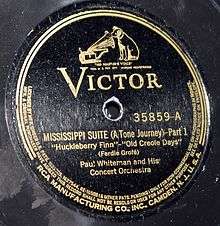Mississippi Suite

The Mississippi Suite (Tone Journey) is a 1925 orchestral suite in four movements by Ferde Grofé, depicting scenes along a journey down the Mississippi River from its headwaters of Minnesota down to New Orleans released as a 78 single on Victor Records by Paul Whiteman and His Concert Orchestra in 1927.
History
The work was composed by Grofé in 1925 and first performed in the summer of that year by Paul Whiteman's orchestra at the Hippodrome Theatre, New York City.
Later, American lyricist Harold Adamson wrote words to music from the ballad theme of the suite's final movement. The resulting song was called "Daybreak". Frank Sinatra recorded "Daybreak" twice, once with Tommy Dorsey and his orchestra on July 1, 1942, and nineteen years later, on May 2, 1961, for the album called "I Remember Tommy". (See under Adamson at #) Mississippi Suite incorporates elements from the Gershwins (which Grofe had arranged for) as well as Copland, making this a good example of 'American' classical music.
Movements
- I. Father of the Waters – depicts the birth of the Mississippi River in the streams of Minnesota and the lands of the Chippewa Indians .
- II. Huckleberry Finn – based on the novel The Adventures of Huckleberry Finn by Mark Twain. A short piece ruminating on Huck's prankish nature.
- III. Old Creole Days – Grofe's interpretation of spirituals sung by slaves on the plantations
- IV. Mardi Gras – depicts Fat Tuesday in New Orleans.
The entire piece runs about 17 minutes.
Recordings
Paul Whiteman recorded the work in 1927 in abbreviated form (without first movement) because of the space limitations of the 12-inch 78-rpm disk, the lengthiest recording format available at that time. Whiteman's recording was released by Victor on Victor 35859.[1]
Grofé's Mississippi Suite and Grand Canyon Suite, performed by the Eastman-Rochester Orchestra (i.e. the Orchestra of the Eastman School of Music), conducted by Howard Hanson, were recorded for Mercury Records in May 1958, re-issued on CD in 1995, coupled with the Cello Concerto No. 2 in E minor op. 30 by Victor Herbert, with Georges Miquelle, Cello. (Mercury Living Presence CD 434 355-2). This was the first stereo recording of it.
The first full recording of the work, as Grofé composed and orchestrated it for Paul Whiteman, was made in 2004 by Steven Richman conducting the Harmonie Ensemble/New York and released in 2006 (Bridge Records 9212).
References
- ↑ "Paul Whiteman and his Orchestra". Redhotjazz.com. Retrieved 6 June 2016.
